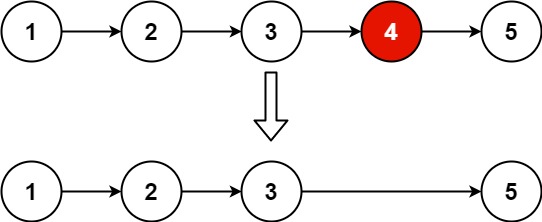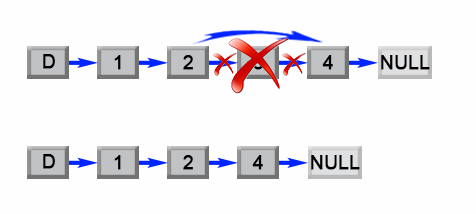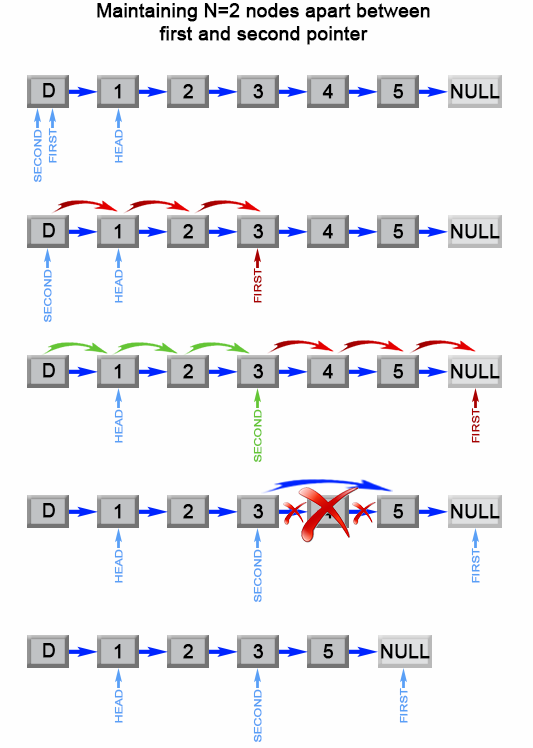6. Remove Nth Node From End of List
Given the head of a linked list, remove the nth node from the end of the list and return its head.
Example 1:

Input: head = [1,2,3,4,5], n = 2
Output: [1,2,3,5]
Example 2:
Input: head = [1], n = 1
Output: []
Example 3:
Input: head = [1,2], n = 1
Output: [1]
Constraints:
- The number of nodes in the list is
sz. 1 <= sz <= 300 <= Node.val <= 1001 <= n <= sz
Follow up: Could you do this in one pass?
Solution Article
Summary
This article is for beginners. It introduces the following idea:
Linked List traversal and removal of nth element from the end.
Approach 1: Two pass algorithm
Intuition
We notice that the problem could be simply reduced to another one : Remove the (L-n+1) th node from the beginning in the list , where L is the list length. This problem is easy to solve once we found list length L.
Algorithm
First we will add an auxiliary "dummy" node, which points to the list head. The "dummy" node is used to simplify some corner cases such as a list with only one node, or removing the head of the list. On the first pass, we find the list length L. Then we set a pointer to the dummy node and start to move it through the list till it comes to the (L-n) th node. We relink next pointer of the (L-n) th node to the (L-n+2) th node and we are done.

Figure 1. Remove the L - n + 1 th element from a list.
Solution:
- JavaScript
- C++
var removeNthFromEnd = function (head, n) {
let dummy = new ListNode(0);
dummy.next = head;
let length = 0;
let first = head;
while (first !== null) {
length++;
first = first.next;
}
length -= n;
first = dummy;
while (length > 0) {
length--;
first = first.next;
}
first.next = first.next.next;
return dummy.next;
};
class Solution {
public:
ListNode* removeNthFromEnd(ListNode* head, int n) {
ListNode* dummy = new ListNode(0);
dummy->next = head;
int length = 0;
ListNode* first = head;
while (first != NULL) {
length++;
first = first->next;
}
length -= n;
first = dummy;
while (length > 0) {
length--;
first = first->next;
}
first->next = first->next->next;
return dummy->next;
}
};
Complexity Analysis
-
Time complexity : O(L).
The algorithm makes two traversal of the list, first to calculate list length L and second to find the (L-n) th node. There are 2L-n operations and time complexity is O(L).
-
Space complexity : O(1).
We only used constant extra space.
Approach 2: One pass algorithm
Algorithm
The above algorithm could be optimized to one pass. Instead of one pointer, we could use two pointers. The first pointer advances the list by n+1 steps from the beginning, while the second pointer starts from the beginning of the list. Now, both pointers are exactly separated by n nodes apart. We maintain this constant gap by advancing both pointers together until the first pointer arrives past the last node. The second pointer will be pointing at the nth node counting from the last.
We relink the next pointer of the node referenced by the second pointer to point to the node's next next node.

Figure 2. Remove the nth element from end of a list.
Solution
- JavaScript
- C++
function removeNthFromEnd(head, n) {
let dummy = new ListNode(0);
dummy.next = head;
let first = dummy;
let second = dummy;
// Advances first pointer so that the gap between first and second is n nodes apart
for (let i = 1; i <= n + 1; i++) {
first = first.next;
}
// Move first to the end, maintaining the gap
while (first !== null) {
first = first.next;
second = second.next;
}
second.next = second.next.next;
return dummy.next;
}
/**
* Definition for singly-linked list.
* struct ListNode {
* int val;
* ListNode *next;
* ListNode(int x) : val(x), next(NULL) {}
* };
*/
class Solution {
public:
ListNode* removeNthFromEnd(ListNode* head, int n) {
ListNode dummy(0);
dummy.next = head;
ListNode* first = &dummy;
ListNode* second = &dummy;
// Advances first pointer so that the gap between first and second is n
// nodes apart
for (int i = 1; i <= n + 1; i++) {
first = first->next;
}
// Move first to the end, maintaining the gap
while (first != NULL) {
first = first->next;
second = second->next;
}
second->next = second->next->next;
return dummy.next;
}
};
Complexity Analysis
-
Time complexity : O(L).
The algorithm makes one traversal of the list of L nodes. Therefore time complexity is O(L).
-
Space complexity : O(1).
We only used constant extra space.